#Essex Regiment
Explore tagged Tumblr posts
Text
#OTD in 1920 – IRA 3rd Cork Brigade personnel attacked a lorry carrying British troops from the Essex Regiment at the Toureen Ambush, on the road between Bandon and Cork.
Up until the ambush the 3rd West Cork Brigade Flying Column had not before engaged the British troops stationed in Co Cork in a proper battle. The Brigade had finished its training and to get it ready for combat it had to get in an engagement with the British soldiers. Under Tom Barry at Toureen, near Ballinhassig, on the old main road between Bandon and Cork city, at 4 a.m. on 22 October 1920,…
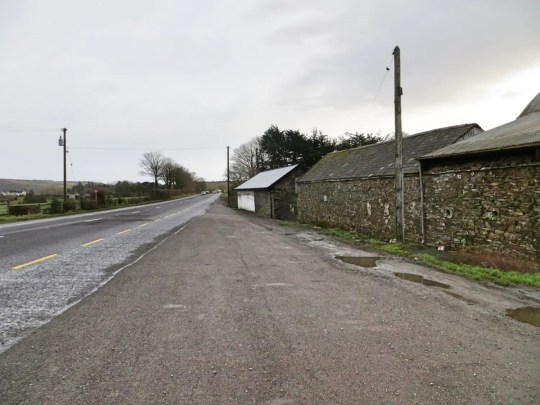
View On WordPress
#Ambush#Bandon#British soldiers#Charlie Hurley#Co. Cork#Cork City#Cork to Innishannon Road#Essex Regiment#IRA 3rd Cork Brigade#Ireland#Irish History#Irish War of Independence#Liam Deasy#Tom Barry#Toureen Ambush site#Victoria Barracks
8 notes
·
View notes
Text

"Phil Murphy Conducts Massed Military Bands Overseas," Windsor Star. April 20, 1943. Page 3. ---- WELL known in Windsor as a band conductor, Bandmaster Phil Murphy, WO. 1, who is overseas with the Canadian Armored Corps, is seen at the right conducting a Canadian Armored Corps band somewhere in England. In the picture at the left, he is seen conducting massed military bands in a concert at Hyde Park during the Wings for Victory Campaign. "There is not much sign of war, is there?" he observed in a note attached to the picture which shows the huge turnout. Bandmaster Murphy was in charge of the brass band of the Essex Regiment (Tank), now the 30th (R.) Reconnaissance Regiment, before he went overseas.
#overseas service#canadian corps#cansdian armored corps#mechanized regiment#tank regiment#military band#victory bond campaign#essex regiment#world war ii#canada in the british empire#canada during world war 2
0 notes
Text
Martin Freeman begins the D-Day 80 service by reading the memories of veteran Joe Mines
Joe Mines, 2nd Battalion Essex Regiment, landed here on Gold Beach 80 years ago today. He joins us and allowed me to share these memories with you: “I've never been back here, for 80 years. I’ve often thought “What do I go back for?” After all the terrible things I’ve seen. Like a picture book, up there, I can visualise everything. I landed on June the 6th 1944 at a place called Vers Sur Mer. The Germans pulled back, so it allowed us to clear the mines on the beach.That was the 1st job I got, clearing mines. All over the place they were. Joe Mines clearing mines. One of our fellas trod on one and blew his leg off. The whole leg went. War is brutal. Back when I signed up, I met a fella on the train. I went to Normandy with him. But he got killed within about an hour of landing here. He was only young. I was 19 when I landed, but I was still a boy. I don’t care what people say. I wasn’t a man. I was a boy. And I didn’t have any idea of war and killing. I was lucky. Yeah, I had lots and lots of luck. So why would I come back? Well, this is the last and only opportunity for me.The last there will ever be. And it’s because of the lads. I want to pay my respects to those who didn’t make it. May they rest in peace. “
#martin freeman#d day#d day 80#normandy#veterans#ww2#ww2 history#wwii#wwii history#world war ii#world war 2#gold beach#allied forces#my vids
194 notes
·
View notes
Text
Levels of Getting to Know Ancano
Because this mer is like an onion. Bitch has layers.
Surface Level:
My god what a prick. Grumpy as shit, always complaining, seems to be picking on you for no apparent reason whatsoever other than that he just wants to blow off steam and bully someone to feel powerful. Comes across like your typical villain, typical Thalmor.
Familiarity:
In this stage, you start to notice that he has routines, but can be fucking messy as fuck. Nothing he does ever goes as he plans it to, and he’s just there for the ride. You start to notice that there’s more to him than just being a dick for the hell of it. Your gaydar starts pinging and you sense that it’s a sore spot.
Acquaintance:
You begin to learn that he’s actually rather sensitive, particularly to criticism, and is both a perfectionist, a nihilist and an idealist all at once, which make for some pretty chaotic encounters. You slowly start to glean in on his micro-expressions and subtle body language, and it clicks into place that he does not even want to be here, and that he is deeply uncomfortable. You feel like part of it is down to the way your gaydar is flying off the rails, but also with an inkling towards him being uncomfortable in his uniform. Whether it’s the cut of it, or what it symbolises is still unclear, all you know is that he’s not happy and looks like he’d rather be doing literally anything else.
Approval:
If you can actually get him to like you, you’ll begin to see him stress out more noticeably, and he won’t hesitate to offload about how shit his quarters are, and how he’d be tempted to walk to the nearest inn if it wasn’t for the shame of encountering Nelacar and getting dirty looks from the nords. It becomes clear that he’s not prideful; he’s self-conscious.
Confidant:
Here’s where it gets down to the nitty gritty. You’ll learn that he is, in fact, gay, from his own lips, and that he only joined the Thalmor to get other mer to leave him alone about it. To him, that uniform was essentially a suit of armour. He never wanted to be a Thalmor spy; he really wanted to be a psijic mage, or an alchemist with his own little shop. But now he’s come this far, he fears that it’s too late to do anything about it, and that the only way one leaves the Thalmor is in a box.
Soulmate:
You’re privy to all of his secrets, fears and desires, and you know a side of him that nobody else does; he is capable of being rather funny. He has running bits and enjoys reading other people to filth in your company for the express purpose of making you chuckle. You also discover that his RP English accent is a mask; his real accent is a fucking flamboyant Essex accent (if you’ve watched Gavin & Stacey he’s literally Pam. “Oh my Christ!!!”). The guard drops down. In a safe environment where he’s free to do what he wants, he’s perfectly happy to sit there and tinker around with the alchemy station and his favourite trick is getting you to watch as he ‘makes the taffy treat scream’ with whatever unholy radioactive shit he’s brewed. He’s quick witted with a potty mouth and his favourite target is Elenwen’s makeup. He once wrote a series of foul letters and made up a fake identity of someone in Solitude and sent them all to various members of the Thalmor, telling Ondolemar to “act like your fucking hairline and disappear, you regimented pisspot of a slut”, writing to Rulindil calling him a “foxy arse beetle-headed twat”, to Ancarion calling him a “salt-chafed dirty sod” and to Elenwen telling her she “looked like someone shoved a fucking thistle up a skeever’s rancid pussy”. Nobody ever figured out it was him.
28 notes
·
View notes
Text
always amused to see Those Specific Bright-Yellow-Lapeled Uniforms out and about in other period dramas... your man's in bernard cornwell's south essex regiment and he doesn't even know it...
#em is posting about sharpe#<- or rather. about reused sharpe costumes.#into the southessexverse...#semi-relatedly. declan fraser sanditon your crossbelt does not fit you right. adjust that or it is going to Fall Off.
14 notes
·
View notes
Text

On 19th January 1644 a Scottish Covenanter army of 20,000 men under the command of Alexander Leslie moved south to support the Parliamentary. Army.
The English civil war is a bit of a misleading name, while the battles between the Roundheads and Cavaliers may have taken place south of the border, the war itself, was for all intents and purposes it was as much a Scottish affair, indeed the start and end of the war involved Scots.
Some of you may know a bit about the rise to power of Oliver Cromwell and his New Model Army; the Battles of Worcester and Naseby and Marston Moor that ended with the execution of King Charles I, to me it marked the beginning of the end of the Stuarts, and it all seems a rather English affair, recently, however, historians have preferred to call it ‘The War of Three Kingdoms’, since both Scotland and Ireland were inevitably drawn into the dispute. It is easy to see why the older version prevailed for so long.
The internet has helped people, like myself understand history better, we can seek out so many sources so easily, at school, if you were lucky you got a textbook with the one version being “gospel” The books we were handed out in Scotland were invariably penned, printed and written by English historians, it is only since devolutin have our bairns been given a chance to learn a more balanced version of history. Even on here I have been called out for getting things wrong, well in the eyes of the person calling me out I certainly will concede certain ground, but history as well is how you perceive it, what to put in my posts and what to leave out.
I rely on some people to keep me right in some respects, and I can’t hold a torch to some people's knowledge of certain aspects of our history, I take my hat off to the some of my friends, whose Jacobite knowledge can put me to shame, these guys live and breath the history, wear the outfits, walk the battlefields and have done for years, mere mortals like me scour the archives piecing together from many sources, like todays post, giving an understanding of events that has been lacking in the classrooms when the super info-highway was still drifting out in space.
Anyway back to the post in hand.
The English story is clear – the extravagant and naïve Charles pitted against the unglamorous and hard-headed Cromwell over a clear point of principle. The Scottish story, however, is much more ambiguous. Indeed, if the ‘English Civil War’ might broadly be dated from 1640, when Charles I dissolved the ‘Short Parliament’, to 1660, when General Monck restored Charles II to the throne, the ‘Scottish Civil War’ could be said to have run from 1637 to 1744, and the final defeat of the Jacobite cause.
Lets start with simple question: to whom did Charles I surrender in 1646? Not to Fairfax, Essex, Ireton or Cromwell, the leading lights in the English Civil War, but to the Scottish regiment encamped at Newark, led by oor ain Alexander Leslie.
Charles, who had of course been born in Scotland, and always had a problem with the Scottish Kirk, who maintained that while the King had authority in matters temporal, they had authority in matters spiritual; and often where one ended and the other began was a point of serious contention. Time and time again I go back to pointing out the Stewart/Stuart, mantra of Devine right of Kings.
James VI as the first King to “rule” over the two Kingdoms of Scotland and England got away with having two forms of worship by not getting too involved with them, Charles however was much more headstrong, his first, and some say biggest mistake was the introduction of his own prayer books on the Scottish Kirk in 1637. It caused a riot, with one woman, Jenny Geddes, purportedly throwing her stool at the minister and shouting ‘daur ye say Mass in my lug?’ They saw it as being to close to the “Popery” of the Catholic church, it led to the drawing up a ‘National Covenant’ which was a solemn agreement inaugurated to reject the prayer book and any meddling by the King in their religion. Don’t underestimate this agreement a staggering six hundred thousand Scots signed the document, in any age, it stated that as long as the king protected the Presbyterian Church, the Presbyterian Church would protect the king. There was the rub.
Charles, forgetting that the word ‘thrawn’ could have been invented to describe the Scottish Church, sorted refused to sign, leading to the so-called First and Second Bishops’ Wars, the latter ending with Montrose and the veteran of the European wars Alexander Leslie in control of Northumbria and County Durham. Charles had to recall the English Parliament for financial support – the ‘Long Parliament’ – and precipitated his war with them.
Parliament now opened negotiations with the Church. Although there were many mutual areas of agreement, the Church of Scotland held both the Independents and the Puritans at arm’s length.
Nevertheless, Westminster and Edinburgh both signed a successor document to the Covenant, the Solemn League and Covenant, which brought the Scots into the fray on the side of Parliament. Even before this, Montrose had already switched sides, concerned that the Kirk was attempting to usurp the power of the Crown, Montrose still had his religious beliefs, he was also a staunch Royalist, which led to his conflicted views.
While Charles was fighting Cromwell he still held out hope that the Scots could wield and come to his rescue, perhaps this is why he surrendered himself to Leslies army and not the Roundheads. What did for him was English gold. The Scots had been promised much and were financially insecure, so in exchange for their prisoner, the English Parliament paid Scottish debts, Leslie’s army had not been paid as promised for allying themselves with Cromwell, with this settled Charles was handed over, eventually to be tried and executed.
The execution of Charles was a turning point. The English had killed the legitimate King of Scots without so much as a by-your-leave. Charles II was proclaimed King of Scots in Edinburgh, and the head of the ‘Engagers’, the Duke of Hamilton, beheaded in London.
Under the Treaty of Breda, Charles II signed the Covenant; an act he did so in supreme bad faith. He needed allies not disputations on theology. Cromwell addressed the General Assembly over the Scots defection, saying: ‘I beseech you, in the bowels in Christ, think it possible ye may be mistaken.’
When the Assembly decided they were not, Cromwell launched a punitive strike and at The Battle of Dunbar, capturing it from Sir David Leslie, ( his brother, Alexander by now aged and retired) beside whom he fought at Marston Moor. Three thousand Scots were killed and 10,000 captured. By the Battle of Inverkeithing, Cromwell had effective control of everywhere south of the Firth of Forth.
But the Scots were intransigent. In the last battle of the ‘English Civil War’, the Battle of Worcester, the majority of the 16,000 strong Royalist force was Scottish. After it around 8000 Scottish prisoners were sent as indentured labourers to the West Indies and Canada, starting a relationship with those regions that would have significant influence in later centuries. Leslie was sent to the Tower, and released a decade later on the successful Restoration of Charles II and the death of Cromwell.
The Scots had instigated the war on their insistence that they were religiously and politically different from England. One unforeseen consequence was that Cromwell’s Commonwealth was the first time Scotland and England had the same governance, he is acknowledged as the only one to invade and control all of Scotland, a feat Longshanks, Edward I never quite accomplished.
Charles II did not heed the lessons of what had happened to his father, and his attempts to create ecclesiastical uniformity led to the ‘Killing Time’ between 1680 and 1688. Even more bizarrely, after the English Parliament invited William III to take the crown, in favour of the Catholic King James VII and II, some Covenanters fought for the Stuarts against the new regime. The misery of war and religious schism makes for strange bedfellows indeed.
At the root, perhaps, of the problem was the difference between the Scottish and English experiences of Stuart monarchy. The Stuarts had ruled Scotland since 1371 and England since 1603. They may have been weak, injudicious, opinionated, divisive and profligate kings – but they had been our kings for a much longer time.
12 notes
·
View notes
Photo

Horatio Gates
Horatio Gates (1727-1806) was an English-born general of the Continental Army during the American Revolutionary War (1775-1783). Initially viewed as a hero for his stunning victory at the Battles of Saratoga, Gates' reputation was later tarnished by both his involvement in the Conway Cabal to replace George Washington as army commander, and his catastrophic defeat at the Battle of Camden.
Early Life & British Service
Horatio Gates was born on 26 July 1727 in Maldon, Essex County, England. He was likely the son of working-class parents Robert and Dorothea Gates; his mother, a housekeeper for the Duke of Bolton, was able to use her position to secure opportunities for her family that otherwise would have been out of reach. For instance, through her friendship with the waiting-maid of the Walpole family, Dorothea Gates managed to get future English writer and politician Horace Walpole (who was 11 years old at the time) to be the godfather of her son. In 1745, 18-year-old Horatio Gates was able to purchase a commission as an ensign in the British Army, largely thanks to the influence of the Duke of Bolton.
The young Ensign Gates has been described by biographers in unflattering terms; one characterized him as a "little ruddy-faced Englishman peering through his thick spectacles" and a "snob of the first water" (quoted in Boatner, 412). He first served with the 20th Regiment of Foot in Germany during the War of Austrian Succession (1740-1748) before volunteering to travel to Halifax, Nova Scotia, to serve under its governor, Edward Cornwallis; Cornwallis was not only an early mentor to Gates but also the uncle of Lord Charles Cornwallis, who would one day face Gates on the battlefield. Promoted to the rank of captain in the 45th Regiment of Foot, Gates saw action against the Mi'kmaq and Acadians in Canada. In 1754, he married Elizabeth Philips, daughter of a Nova Scotia councilman, with whom he would have one son, Robert (b. 1758).
In 1755, as the French and Indian War (1754-1763) was escalating in North America, British General Edward Braddock was sent to lead an expedition to capture the French-held Fort Duquesne and thereby assert British control of the Ohio River Valley. Gates traveled to Fort Cumberland, Maryland, to join the expedition, where he would have met several other men who would one day also play key roles in the American Revolution including Daniel Morgan, Thomas Gage, Charles Lee, and, of course, Lt. Colonel George Washington of the Virginia militia. Braddock's Expedition set out on 29 May 1755 and made it to the Monongahela River a little over a month later, where it was ambushed by French troops and their Indigenous allies. General Braddock was killed in the ambush, and a large portion of his army became casualties including Gates, who was wounded. The survivors retreated to friendly territory.
After the Battle of the Monongahela, Gates was mainly relegated to positions of military administration, something at which he proved exceptionally talented. He served as chief-of-staff first to Brigadier General John Stanwix and then to Stanwix's replacement, Robert Monckton. In 1762, Gates accompanied Monckton in the capture of Martinique. Although Gates did not experience much combat during the expedition, he was nevertheless tasked with bringing news of the victory to England and was rewarded with a promotion to the rank of major. The war ended the following year and Gates returned to England, only to realize he had little future in the British Army; the limitations put on him by his social status meant that he could not advance much further in the military than he already had. Frustrated, Gates sold his major's commission in 1769 and, with assistance from his old army comrade George Washington, moved to Virginia with his family. Gates purchased Traveler's Rest, a Berkeley County plantation next door to Washington's younger brother, Samuel. As Gates began his new life as a Virginian planter, he also purchased several enslaved people to labor in his fields.
Continue reading...
14 notes
·
View notes
Text

Prussian Hussar regiment No.1, the Green Hussars. Green indeed. Essex 15mm figures, GW contrast paints mostly.
9 notes
·
View notes
Text

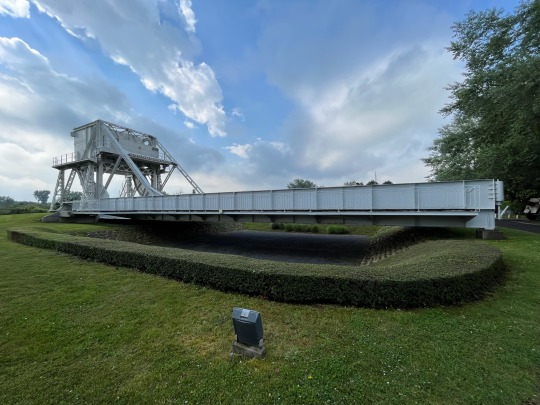


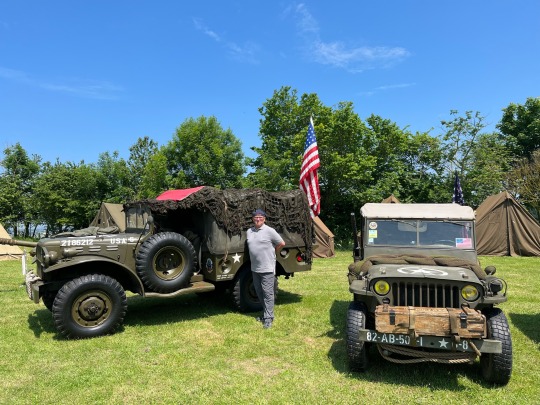
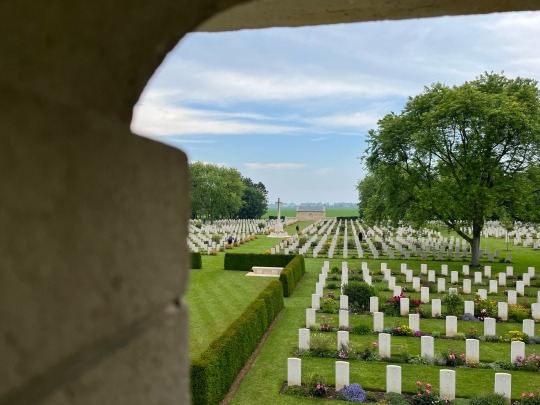
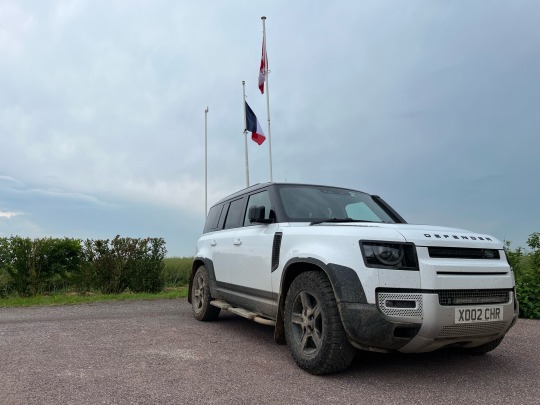



04/06/2022 - Day 1
The location for the group to meet was just a stones throw from Pegasus bridge located in Bénouville. Here we met some familiar faces from a previous BF4x4 tour we did a few years ago. As always an introduction and agenda was shared where most of this tour will be spent in the Calvados (Normandy) area. Today's agenda Pegasus Bridge Memorial Ranville War Cemetery Colleville-Montgomery - The Hillman Fortress Bény-sur-Mer Canadian War Cemetery Arromanches-les-Bains - The Mulberry Harbour/Port Winston
Memorial Pegasus As you would've guessed our first stop was indeed Pegasus bridge memorial/museum, now i'd imagine most would know this but the original captured bridge has been relocated away from the canal and the one you drive/walk over is a replica. The site is dedicated to the men of the British 6th Airborne Division who were the first Allied troops to arrive in Normandy on the night of the 5th/6th of June 1944 where a small detachment of the 6th British Airborne Division surprised the German garrison guarding the bridges. The BF4x4 guides arranged for a guided tour to walk us through step by step how the assault unfolded and we were even lucky enough to meet a veteran - Well worth a visit.
Ranville War Cemetery
1.4 kilometres down the ride (3 minute drive) is the Ranville War Cemetery. Ranville was the first village to be liberated in France when the bridge over the Caen Canal was captured intact in the early hours of 6th June by troops of the 6th Airborne Division, who were landed nearby by parachute or glider. Many of the division's casualties are buried in Ranville War Cemetery.
The cemetery contains around 2,236 Commonwealth burials of WW2, 90 of them unfortunately are unidentified and 323 German graves. The churchyard also contains 47 Commonwealth burials, one of which is unidentified, and one German grave.
One grave of interest was of Private Emile Corteil, he was from Watford in Hertfordshire and served with A Company, 9th (Essex) Parachute Battalion. Corteil was the dog handler for the company, and his dog was called Glen. Both parachuted into France with their company on D Day, Emile was killed on D Day aged 19 years; Glen was also killed and the two were found lying together.
Colleville-Montgomery - The Hillman Fortress
From Ranville we head 7.5km northwest to The Hillman Fortress which sits south of the town Collevill-Montgomery. The Hillman Fortress was a command post among the German coastal defences on the Normandy beaches which was built between 1942 and 1944.
The 1st Battalion, Suffolk Regiment liberated the site on the 6th of June 1944 but took longer than expected. The delay in taking the bunker complex has been cited as a reason for the Allies not completing their major D-Day objective of taking Caen. We were fortunate to experience a camp reenactment, this entailed enthusiasts dressing up as allies and Germans with decommissioned weapons and WW2 vehicles. 1940's radio's playing war speeches and also the Jive music like 'Boogie Woogie Bugle Boy' by The Andrews Sisters. It's honestly awesome to be amongst it and i'm sure many have got bitten by the reenactment bug. Once we had completed many laps of the camp and the fortress we has a spot to eat in the back of the 110 mainly cheese, ham and baguette (continental lunch) before heading off to our next destination of the day.
Bény-sur-Mer Canadian War Cemetery
Whilst in convoy heading west over the CB radio Keith informs us that we will be stopping off at another war cemetery, but this contains mostly Canadians. Many of those buried were of the 3rd Canadian Division who died either on 6th June or during the early days of the advance towards Caen, when the Division engaged the German 716th Division and the 21st Panzer Divisions. As you look around any war cemetery it is hard to really comprehend that each headstone represents a lost life and though i'm stating the obvious it's just an overwhelming experience.
Arromanches-les-Bains - The Mulberry Harbour/Port Winston
And just when you thought the day was drawing to an end, when arriving at our accommodation for the next couple of nights which is the very nice Chateau de Bellefontaine. The guys at BF4x4 explained after checking in and freshening up we have a table booked at La Marine which overlooks Gold beach, where the remains of the Mulberry Harbour/Port Winston lie. It was part of mission overlord, where the objectives at Gold Beach were to - Secure a beachhead - Move west to capture Arromanches - Establish contact with the American forces at Omaha - Capture Bayeux and the small port at Port-en-Bessin - Link up with the Canadian forces at Juno to the east
The forces attacking Gold beach faced the German 352nd Infantry Division and German 716th Infantry Division and there were around 350 ally fatalities.
Mulberry "B" (British) was the harbour assembled on Gold Beach at Arromanches for use by the British/Canadian forces. The harbour was decommissioned 6 months after D-Day as the Allies were able to use the recently captured Antwerp port. The harbour was operated by 20 Royal Engineers under the command of Lt. Col. G C B Shaddick.
That will be enough about the history, the food at La Marine was fantastic and the on the house calvados shot (cider brandy) definitely opened up the airways. Based on Day 1... tomorrow is going to be another epic day.
#landrover#defender#landroverdefender#overlander#4x4#defendertd5#overland#td5#defender110#land rover defender#battlefields4x4
14 notes
·
View notes
Text
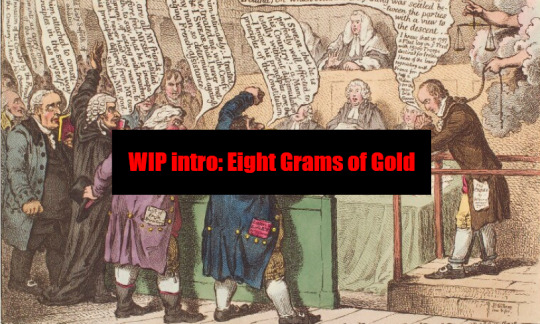
(Detail from James Gillray's political cartoon Evidence to Character: being a Portrait of a Traitor by His Friends and by Himself)
Wip intro: Eight Grams of Gold
Genre: historical fiction, courtroom drama, elements of cosmic horror
Progress: 1st draft
POV: 3rd person limited
Setting: 1795 - 1796 in Ireland + some scenes in England and France
Content warnings: gore / death / abuse / a variety of place-and-time-typical forms of bigotry / cannibalism / etc
Things have not improved for the RRL characters. A stolen shipment of guns, a dead landlord, and now a bizarre personal feud sparked by one man giving another a guinea, which spirals out of control into an esoteric legal battle which threatens to consume everyone and everything. And of course, in the mean time, the spectre of rebellion is looming, and as it is now the year 1796, the clock is slowly counting down.
First, there is Sarah Connolly, a peasant woman, whose son, Frederick, stabs and kills the landlord during the family's eviction. Seeking preservation above all, she sells the body to the innkeeper at the local Essex Arms inn, and washes her hands of the business, content to not ask questions about what innkeeper Lazarus McClure, whose mental stability has been going steadily downhill since the conclusion of the last story, will do with the body and content that she and her family will be safe under their roof for at least another quarter. That is, until it comes out that the Englishman who was meant to inherit his wealth, Charles Nathaniel Maurice Irving-Hamilton, 4th Viscount of Drenning, was recently disinherited in a fit of rage on the part of the man who Frederick stabbed. And the man who will now inherit is a mere bookbinder, a nobody, a tradesman, who infamous aristocratic spymaster Lady Maria Whittaker is incensed to discover will soon be on the same social level as her if he is allowed to acquire the land and the title that would have been Charles' -- who is a bad inheritor, but a suitably titled one.
Whittaker digs up a will. It would seem that the title once came with a lot more land, was severed from it quite by accident in the 1740s, and should, following rather the spirit of the law than the letter, belong to the brother-in-law of the object of Whittaker's very mutual unhinged psychosexual obsession, William Rearden. It isn't too difficult to convince this brother-in-law to contest it. Everyone wants to be a lord, after all. Only, the man who is now a lord refuses to give Whittaker's puppet a thing -- save for a single guinea, handed to him outside church one day as a deliberate mocking gesture. And what's worse, Rearden, who despises his brother-in-law, told him to do it.
AKA: now that I've lured u in with a story about gun-running I will make you listen to me talk about the 18th century Irish legal system for a billion million words ❤️
Ask to be +/- from the taglist!!!
Main Characters
Anthony Franklin -- (he/him) a man of science and lover of liberty from Scotland. A genial family man who loves his friends and chafes at all forms of authority.
Lady Maria Anne Whittaker -- (she/her) a Jacobite-descended Englishwoman whose job it is to get supplies to France, no matter who has to die for it. Loves, apart from herself, her sister.
Eoin O'Donnell -- (he/him) a Defender leader, now on the run from the law. Considered "odd" and "not right" but liked for being very good at terrorism. Has a terminal case of Catholic guilt.
Sarah Connolly -- (she/her) an Irish Catholic peasant woman trapped in an unhappy relationship. Blames herself for a lot but blames other people for more and someday that's going to end very badly for them.
Frederick Craig -- (he/him) Sarah's 11 year old adopted son, recently hired as a drummer boy for the local regiment. Holds a confused ball of resentment within his chest. Has strange dreams.
Annie Craig -- (she/her) Sarah's 12 year old adopted daughter. Considered a touch odd but liked well enough. Determined to find some justice in the situation she finds herself in.
Charles Irving-Hamilton -- (he/him) a worthless Englishman who did not even want to come to Ireland for his uncle's funeral. But he is willing to stay if he can get some entertainment out of ruining this legal battle.
Lady Eliza Durham -- (she/her) a scheming landlady. Has been playing this game a long, long time, long enough to be sure of her ability to best anyone else on this list.
Edward "Lazarus" McClure -- (he/him) a resentment-filled, Derry-born, oak branch-wearing, sham-fighting inn owner. Loves his current fling and Winstanley; hates his father and the law.
Francis "Frank" Borden, Gerald O'Neill -- the new inheritor and Rearden's brother-in-law, respectively.
6 notes
·
View notes
Note
Hello Val. What's your favorite fiction book? And your fav nonfiction? Hope you feel better soon.
non fiction? For sure In the Heart of the Sea by Nathaniel Philbrick. It’s so good, absolutely gripping and really well structured in when and where it explains the history of American society, and economy and various health effects of what the crew of the Essex is going through. You can really see why hearing about these events would have inspired Moby Dick
fiction? Monstrous Regiment, or The Master and Margarita… they’re both really good…
6 notes
·
View notes
Text
#OTD in 1921 – Tom Barry and the West Cork Flying Column routs a superior force from the Essex Regiment at Crossbarry.
A force of 100 IRA members under the leadership of Tom Barry are involved in a major skirmish with up to 1,000 British troops at Crossbarry, Co Cork. English intelligence had determined that Barry’s West Cork Brigade was based near Crossbarry and planned a major encirclement and assault. Poor planning and timing ensured the 1,000 plus British forces got separated before attacking Barry’s men.…

View On WordPress
#British Essex Regiment#Co. Cork#Crossbarry#Crossbarry Ambush Memorial#IRA#Ireland#Irish History#Irish War of Independence#Tom Barry#West Cork Flying Column
4 notes
·
View notes
Text

"Hairdressers Launch War Stamp Drive," Windsor Star. January 12, 1943. Page 5. --- FOUR Miss Canada Girls attended a meeting of the Hairdressers Association of Western Ontario in the Prince Edward Hotel last evening, inaugurating a war savings stamps campaign by the hairdressers. Seated are Mr. J. Edgar Young (left), manager of the Windsor office of the Wartime Prices and Trade Board, and representative of the National War Finance Committee here, and Acting Mayor Arthur L. Mason. At right is Mr. Robert G. Cohen, chairman of the evening, chatting with the Miss Canada Girls and Private P. Markesino, Essex Scottish Regiment, St. Luke Road Barracks.
#windsor#hairdressers#hairdressers association#war savings#fundraising campaign#war effort#wartime prices and trade board#war finance#miss canada#essex scottish regiment#canada during world war 2
0 notes
Text

Ramsay Bader was a tank driver in the 147th (Essex Yeomanry) Field Regiment, Royal Horse Artillery of the British Army. As part of the 147th, Ramsay Bader participated in the D-Day invasion of Normandy on June 6th 1944. Any mention of Ramsay Bader is incomplete without also mentioning his wife Lilian Bader (née Bailey), a Black British woman, who served in the Women's Auxiliary Air Force and reached the rank of Acting Corporal. Lilian Bailey and Ramsay Bader married during the war in 1943.
On the eve of D-Day, Lilian remembered: "I didn't know if Ramsay was alive or dead... I remember kneeling in the chapel and praying like blazes that Ramsay would be saved. It was a terrible time because you knew some people were going to be killed, and Ramsay couldn't swim! He hated water. That's what worried me more than anything, but he came through." (Quoted in The Independent)
Ramsay Bader survived and saw the war through to the fall of Nazi Germany. So did Lilian. They would go on to live long lives, Ramsay passing away in 1992 and Lilian quite recently in 2015. Together they are a testament to the experience of the Black British community during WW2 and there are many stories just like theirs lost to history or just waiting to be recovered.
2 notes
·
View notes
Text

The Hornet No. 381, dated 26 December 1970. The Hornet Gallery of Courage - Terror Came at Christmas cover, retelling the story of Joseph Edward Mott GC (1914-1983).
"The KING has been graciously pleased to approve of the Award of the Medal of the Military Division of the Most Excellent Order of the British Empire to the undermentioned:– For Gallantry. No. 6009084 Private Joseph Edward Mott, 1st Battalion, The Essex Regiment. At about 8.20 p.m. on the 25th December, 1937, a bomb was thrown into the Jordania Café, Haifa. The Café was crowded with soldiers and civilians at the time. The bomb fell at the feet of Private Mott who was seated at a table with some other men of the Battalion. With the utmost coolness and presence of mind, Private Mott picked it up and hurled it through the window into the street, where it exploded with great violence. This highly courageous act undoubtedly saved several lives, and injuries to many" - The London Gazette of 25 February 1938. DC Thomson.
#26dec#1970#christmas#the hornet#the hornet gallery of courage#private mott#joseph edward mott#george cross
2 notes
·
View notes
Text

Sometimes I think about whether Jane Austen's works exist as either books or like... actually in the Sharpe universe. Sam and I have talked about when Sharpe goes to England during Regiment, he's looking for a gift for Teresa and picks up Pride and Prejudice because he's told it's incredibly popular, and he brings it back to Spain and they devour the book. Teresa can't get enough of her works, and when they're traveling through England between Revenge and Justice, they make some stops at some places mentioned in the books, like the Lake Country, the gardens at Kent, etc. But also in the 2005 P&P the militia stationed in Meryton are wearing the very distinct uniform of the South Essex, which isn't a real regiment...implying Wickham is part of the South Essex, and that the Sharpe universe exists inside the P&P one as well... Personally I prefer the former- I like Teresa reading the books out loud to Sharpe and the two of them being enrapt by it, but especially Teresa- it's her first real introduction to English culture and society and how it works so she's fascinated but it is fun to think about Sharpe kicking Wickham's ass if he ever came to the Peninsula (which he doesn't ofc, he goes North, but STILL lmfao)
#;ooc#(I always think of the 1995 P&P as my canon one bc that was my first and favorite)#(this came about bc i was eating lunch and watching the making of the 1995 one and i got overwhelmed by the music and started to cry)#(bc im on my period and im emotional LMFAOO i just love the 1995 one sooooo much its so important to me. and the music is SO GOOD)#)#(we also joked that Sharpe and JA ran into each other bc both were summoned by the prince regent (well. JA was summoned by his librarian))#(and theyre both annoyed by it LOL)#(jane austen 🤝 sharpe both disliking the prince regent)
3 notes
·
View notes